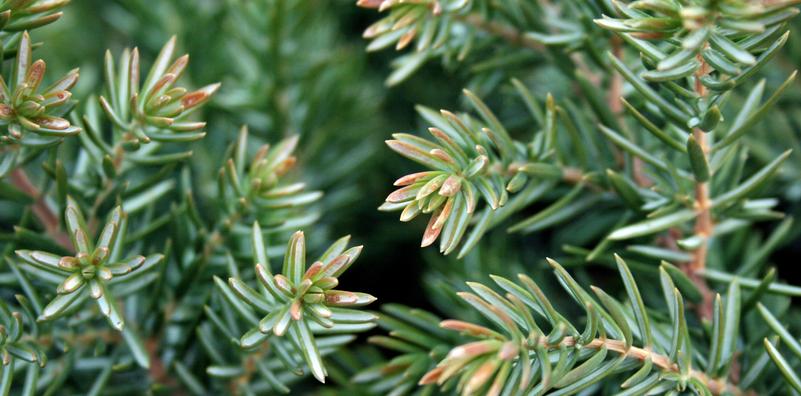Just Juniper Things
How could we try to get through the rest of the winter without having at least one week dedicated to an all-time-classic conifer? The humble juniper, a staple in gardens and landscapes throughout the world, is no stranger to even the least knowledgeable plant people. The aromatic, evergreen needles, similarly fragrant, glaucous blue berrylike cones, and universally widespread range makes Juniperus perhaps one of the most recognizable genera in the plant kingdom. Why are junipers so special, though? It’s just a coniferous evergreen, after all – why and how have they developed such a loyal fanbase throughout horticultural history to become not only a landscape standard, but a collector’s item? Surely, there must be something beyond the branches that has enchanted and bewitched folks for centuries. Well, buckle up, buckaroos, because this week we’re going on a Juniperus deep dive.
While all groundcover junipers might initially seem the same to the untrained eye, the variations in needle shape, size, and color truly differentiate one from species from the next, and one variety from the other. There seems to be a flavor of juniper for every taste, landscape, or site-specific installation that could possibly exist. That’s not by accident – junipers are some of the oldest coniferous species in the fossil record, with several of the oldest recorded in the genus located right here in the United States – the largest, and oldest, of which is known as the Bennett Juniper, located in Stanislaus National Forest in California, reaching more than 80’ in height, approximately 60’ feet in canopy width, and approximately 3,000 years of age. That said, junipers have been around long enough to really experiment with their genome sequencing, resulting in quite an extensive list of landscape-ready selections as well as man-made variations intended to have ideal ornamental traits. But surely, junipers haven’t always been cultivated for their ornamental or landscape properties. In fact, junipers have a long cultural history as medicinal and magical herbs, with roots in traditional pharmacopeia as far back as the Ancient Greeks and Romans.
Traditionally, it is the berrylike cones that have garnered quite a complex record across the history books. Perhaps best known for their use as a flavoring agent in beverages, specifically in alcoholic drinks such as gin, the berrylike cones (typically of Juniperus communis, although other species are also utilized) are known to have an array of medicinal properties, including but not limited to being antibacterial, antiviral, antifungal, anti-inflammatory, antioxidant, as well as being packed with vitamins and nutrients that may be beneficial for heart health and lowering cholesterol. Some species of juniper exhibit analgesic, anticonvulsant, diuretic, anti-ulcerative, anti-parasitic, astringent, and even anti-tumor properties. Famously, the cones have been added to whisky, and are the primary flavoring agent in gin, although it is thought that the alcohol was originally consumed as a slightly-more-palatable carrier for the medicinal constituents within the bitter, pungent cones. Besides the extensive list of benefits above, the addition of the cones to an apéritif or digestif are known to help stimulate digestion after eating a meal, which assisted their increasing popularity in further alcoholic concoctions. It should be no surprise, then, after reading through how fully-encompassing juniper is thought to be for nearly every bodily function, that spiritually and magically, junipers have been associated with protection and banishment of evil spirits. From the Gaels and Celts of previous millennia, to Native Americans of yesteryear, junipers have long been regarded as plants with the ability to purify and protect, even used to cleanse ritual spaces when burnt as an incense.
So, when did junipers go from magical, medicinal plants to predominant landscape plants? Well, the timeline is a little fuzzy – their history is so richly entwined with the existence of human beings that pinpointing an exact time that junipers came into cultivation is tricky. However, it is thought that perhaps some of the first utilized junipers were in fact Juniperus chinensis, Chinese juniper, which were used in bonsai practices starting sometime around 700 A.D. Eventually, Western civilization caught wind of junipers as landscape plants likely sometime around the mid-to-late 1700’s after a written introduction by Carl Linnaeus. And now, almost 300 years later, you can find an ornamental juniper nearly everywhere you turn. From the varied forms, colors, shapes and sizes of Juniperus chinensis, to the creeping, low-growing selections of Juniperus horizontalis, there is a landscape juniper right for nearly every situation. After all, “if you cannot grow junipers, then do not bother planting anything else”!
Bennett Juniper Stewardship Project - Save the Redwoods League
Juniper mythology and folklore | Trees for Life
Juniperus (juniper) description (conifers.org)
Chinese juniper | The Morton Arboretum
CHINESE JUNIPER - JUNIPERUS CHINENSIS | The UFOR Nursery & Lab (umn.edu)
Juniperus horizontalis (usda.gov)
How to Plant and Grow Chinese Junipers | Gardener’s Path (gardenerspath.com)
See all our Woody Ornamentals
